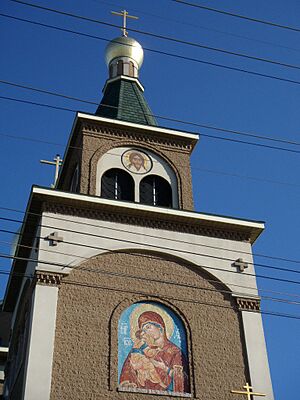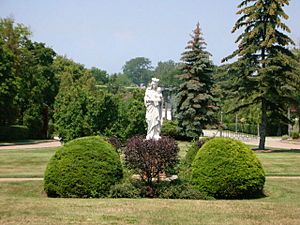Demographics of Erie, Pennsylvania facts for kids
Erie, Pennsylvania, is a city that has seen its population change a lot over the years. According to the 2000 census, about 103,717 people lived there. This means the city had about 1,823 people living in each square kilometer. There were also about 40,938 households, which are groups of people living together in one home.
Erie's population has been getting smaller since the 1970s. This is mainly because many businesses and factories have moved away. The city has lost over 40,000 people since then.
| Historical population | |||
|---|---|---|---|
| Census | Pop. | %± | |
| 1800 | 81 | — | |
| 1810 | 394 | 386.4% | |
| 1820 | 635 | 61.2% | |
| 1830 | 1,465 | 130.7% | |
| 1840 | 3,412 | 132.9% | |
| 1850 | 5,858 | 71.7% | |
| 1860 | 9,419 | 60.8% | |
| 1870 | 19,646 | 108.6% | |
| 1880 | 27,737 | 41.2% | |
| 1890 | 40,634 | 46.5% | |
| 1900 | 52,733 | 29.8% | |
| 1910 | 66,525 | 26.2% | |
| 1920 | 93,372 | 40.4% | |
| 1930 | 115,967 | 24.2% | |
| 1940 | 116,955 | 0.9% | |
| 1950 | 130,803 | 11.8% | |
| 1960 | 138,440 | 5.8% | |
| 1970 | 129,231 | −6.7% | |
| 1980 | 119,123 | −7.8% | |
| 1990 | 108,718 | −8.7% | |
| 2000 | 103,717 | −4.6% | |
| 2010 | 101,786 | −1.9% | |
| 2018 (est.) | 96,471 | −5.2% | |
| Population 1880 - 1970. Population 1980-2000 |
|||
Contents
Who Lives in Erie?
Most people in Erie are White, making up about 80.6% of the population. About 14.2% are African American. Smaller groups include Native American, Asian, and Pacific Islander people. About 1.9% of people are from other backgrounds, and 2.3% are from two or more backgrounds. Also, about 4.4% of the population is Hispanic or Latino.
Households and Families
Out of all the households in Erie, about 29.2% have children under 18 living there. About 38.2% are married couples. Some households (16.8%) have a female head with no husband present. About 40.2% of households are made up of individuals or non-family groups. Many people (33.4%) live alone, and 13.3% of these are people aged 65 or older. On average, there are about 2.39 people in each household.
Age Groups in the City
The population in Erie is spread out across different age groups. About 25.4% of people are under 18 years old. Around 11.6% are between 18 and 24. The largest group, 28.5%, is between 25 and 44 years old. About 19.2% are between 45 and 64, and 15.4% are 65 years or older. The average age in Erie is 34 years.
Income and Earnings
In Erie, the average yearly income for a household was about $28,387. For families, the average income was around $36,446. Men generally earned more than women. The average income per person in the city was about $14,972. About 18.8% of the population lived below the poverty line. This included 27.0% of those under 18 and 10.3% of those 65 or older.
Diverse Backgrounds and Communities
Erie is home to many different ethnic groups. The largest groups include people of German (24%), Irish (14%), Polish (14%), and Italian (13%) backgrounds. Other groups include English, Swedish, French, and Russian people.
Welcoming Refugees
Since the mid-1990s, an organization called the International Institute of Erie (IIE) has helped refugees from many countries settle in the city. These countries include Bosnia, Eritrea, Ghana, Iraq, Kosovo, Liberia, Nepal, Bhutan, Burma, Somalia, Sudan, the former Soviet Union, and Vietnam.
Erie has been welcoming refugees since 1919. In 2009, the IIE officially became part of the U.S. Committee for Refugees and Immigrants (USCRI). Since 2008, Erie has welcomed over 13,500 refugees. Many of these refugees came from Burma, Somalia, and Iraq. In 2020, Erie was named a "Certified Welcoming Place" because of its efforts to help newcomers.
Religious Communities
Erie has a Jewish community that is over 150 years old. They have a synagogue called Temple Anshe Hesed.
The city also has a significant Russian immigrant community, many of whom worked in shipbuilding in the early 1900s. Some of these Russian immigrants were "Old Believers," a special group within the Russian Orthodox Church. Even today, the gold-domed Church of the Nativity is an Old Believer church.
Erie is also home to the Roman Catholic Diocese of Erie, which covers 13 counties. The main church for the diocese is the Saint Peter Cathedral in Erie. It was built in 1873 and has a very tall central tower, making it one of the tallest churches in the U.S.
According to information from 2000, out of about 280,843 people in Erie County, over 103,000 were Catholic. Many others belonged to different Protestant churches.
Images for kids





